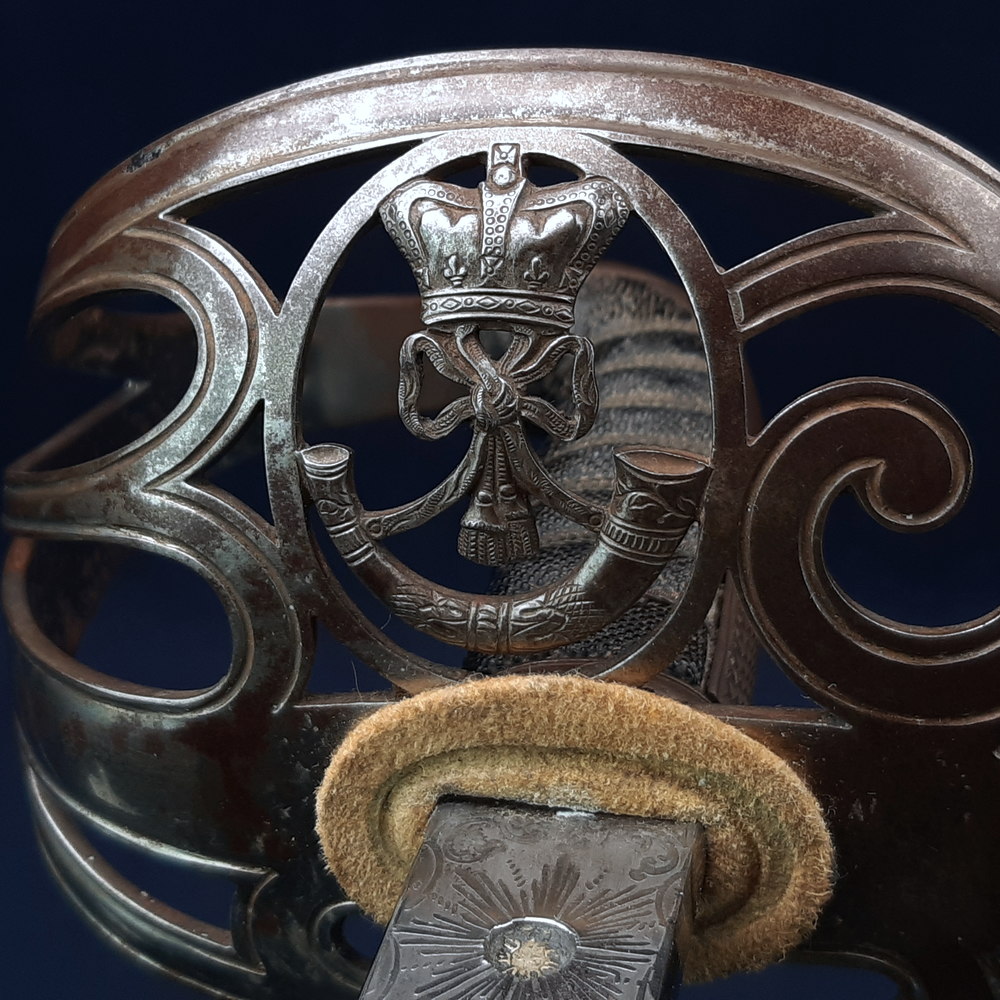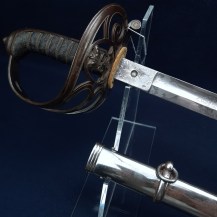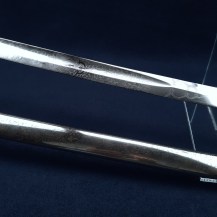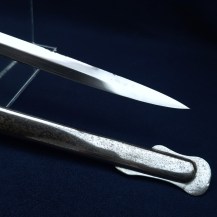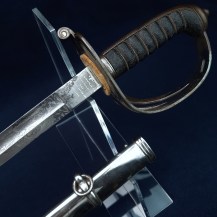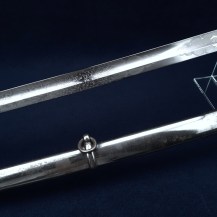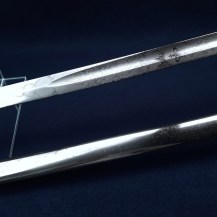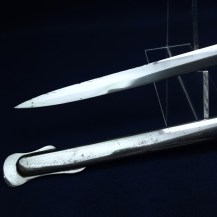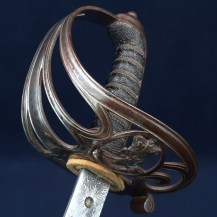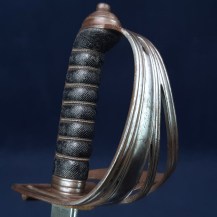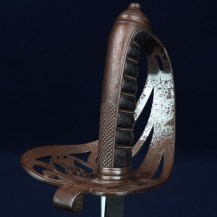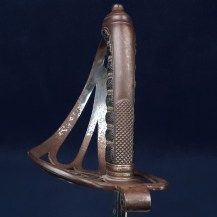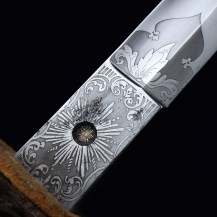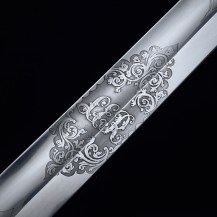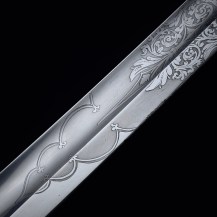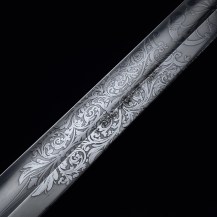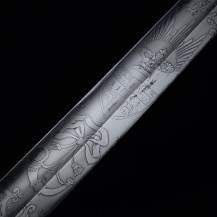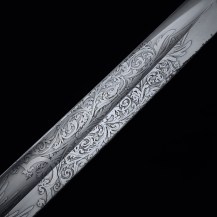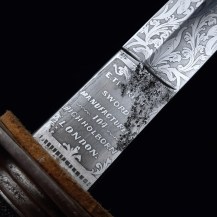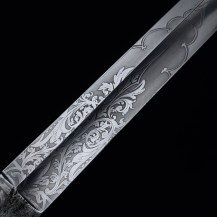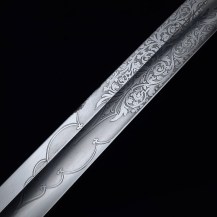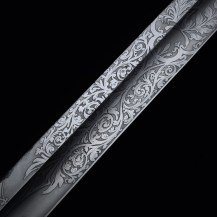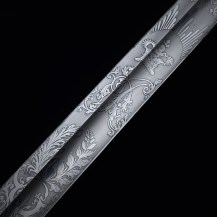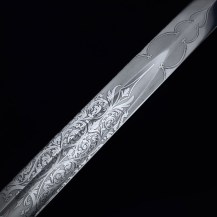Cambridge University Rifles 1827 Pattern Rifle Officer’s Sword, c1866 by Thurkle, of Sir Lucas Eustratios Ralli, 1st Baronet
Slightly curved spear-pointed blade with fuller. Pierced steel hilt of ‘Gothic’ style with inset crown & strung bugle badge of the light infantry. Steel ferrule, partly chequered backstrap and stepped oval pommel cap. Wire-bound black shagreen grip. Buff leather washer. Steel parade scabbard with two hanging rings. Blade 32¼ inches in length, the sword 37¾ inches overall.
The blade has a brass proof slug at the forte on one side stamped with a six-pointed star and ‘PROVED’, with an rayed star etched around the proof slug. It is further etched on that side with the owner’s initials ‘LER’ within an ornate cartouche, a strung bugle badge of the Rifle Corps, the coat of arms of Cambridge University beneath a crown, and foliate motifs. On the other side the blade is etched at the forte with the maker’s mark ‘E THURKLE SWORD MANUFACTURER 104 HIGH HOLBORN LONDON’, and further up the blade with the crown and cypher of Queen Victoria, victor’s laurels and foliate motifs.
Lucas Eustratios Ralli was born in London in 1846, son of Eustratios Stephanos Ralli. The Ralli family were merchants from the Greek island of Chios, one of many branches supposedly descended from a Norman aristocrat named Raoul who defected to the Byzantine Empire. They were already wealthy when in 1815 the patriarch, Stephanos Ralli, sought to take advantage of the fall of Napoleon and subsequent changes to European trade routes. He moved their trading business off the island to offices in Marseille and London, dispatching his five sons to establish an east-west network trading British textiles for grain from Odessa and Constantinople, with Eustratios positioned in Manchester overseeing the textile exports.
This arrangement was not only profitable but also saved all of their lives, as the Ottoman Empire conquered Chios in 1822 during the Greek War of Independence, massacred its population and took most of the survivors into slavery. Predicting wars and successfully trading from their consequences seem to have been one of the family’s talents and the trading company went from strength to strength, establishing offices across the Mediterranean, in the United States and a large operation in India from 1851, the latter timed perfectly to sell Indian jute as a substitute for Russian hemp no longer available due to the Crimean War.
The Ralli family were the wealthiest and most successful Greek expatriates in Victorian Britain, and Lucas would have been born in considerable luxury but with high expectations. During his childhood his uncle Pandia Ralli, one of the five original sons, had taken the company to new heights and became an eminent figure in their community. Pandia generously assisted fellow Greeks in Britain but also used his family’s commercial might to enforce his personal high standards for fair dealing - earning him the nickname among them of ‘Zeus’. He was appointed the first Greek Consul in London in 1835, helped build a Greek Orthodox church at London Wall and was responsible for the Greek stand at the Great Exhibition of 1851.
Lucas attended Harrow school then Trinity College, Cambridge. An albumen print photograph of him in 1861, aged around 15, is in the collection of the National Portrait Gallery (NPG Ax52231) and is viewable online here. He joined the Cambridge University Rifles as an Ensign in 1866.
The Cambridge University Rifles claimed its founding in 1803 from a corps of undergraduate volunteers formed in response to the threat of French invasion. It was formally raised in 1860, however, as the 3rd Cambridgeshire (Cambridge University) Rifle Volunteer Corps, with the Prince of Wales as honorary Colonel. It was very popular among the student body and as might be expected, it had a rivalry with the 1st Oxfordshire (Oxford University) Rifle Volunteer Corps, particularly in shooting competitions. Lucas would have purchased his own sword as part of his new Rifles uniform and one can see the pride taken in his membership: this is a particularly fine example of a Rifles sword with detailed working on the hilt and custom etching including the badge of the university that he would have had to commission from a sword manufacturer like Thurkle, not merely buy off the shelf from a military outfitters. Lucas’s military career appears to have gone no further than his college days, and what he did in general for some years after graduation is unclear.
After Pandia Ralli died in 1865 Lucas’s brother John and cousin Stephen, both of them Pandia’s proteges in different arms of the business, reorganised the family firm into a new Ralli Brothers Ltd. John, who was 11 years Lucas’s senior, died in 1879 and Lucas joined the partnership afterward to take his older brother’s place.
He retired in 1892 but returned to the firm again in 1902 when Stephen died, passing control of Ralli Brothers entirely to Lucas. Lucas ran the company well through difficult times, axing their struggling American cotton business and securing the entire British government contract for jute sandbags on the outbreak of WW1. He was created a baronet in 1912, the family’s generations of business success finally securing a place among British nobility. The stock market crash of 1929 and subsequent Great Depression forced him to close down operations in India. He married Eugenia 'Janie’ Argenti, a daughter of another prominent Chiot merchant family in London, with whom he had five children.
Lucas’s younger son Leonidas died of an illness in Monaco in 1917 while on service with the Royal Army Service Corps, at the rank of Captain. His elder son Eustratius ‘Strati’ Ralli served with the Middlesex Imperial Yeomanry in the Boer War, and with the Royal Field Artillery in WW1, reaching the rank of Captain. He earned the Military Cross in 1918 for gallantry:
For conspicuous gallantry and devotion to duty when in charge of a party delivering ammunition. One man was killed and five wounded, and but for his efficient control the casualties would have been greater. When, two men were reported missing he remained behind for six hours searching for them, eventually tracing them to a dressing station.
Lucas died in 1931 in a Swiss nursing home, leaving an estate valued at £2,290,447, which would be more than £135 million today. He is buried at the Greek Orthodox Cemetery at West Norwood, London, which his uncle Pandia had helped establish in 1842. His son Strati took over operation of Ralli Brothers and inherited the baronetcy. His direct descendant Sir David Charles Ralli is the current 4th Baronet.
The blade is bright with a mirror polish, its etching is crisp and bright with mild contrast between the reflective designs and matt background, most notable in the initialled cartouche. A few spots of patination mainly along the edges but a few slightly impacting the etching, as well as two small areas of cleaned pitting which impact the maker’s mark on one side and some foliage on the other. Its edge is unsharpened and tip undamaged. The backstrap, pommel, quillon, one side of the ferrule and top side of the guard are patinated while much of the bars and knucklebow are bright with spots of patination. The shagreen of the grip is all intact with light handling wear, the wire binding is all present and tight with fractional movement to one loop nearest the ferrule. The steel scabbard is likewise highly polished, it is free of dents although there is a fair amount of frosting and speckled light patination, a few very small spots of cleaned pitting.

